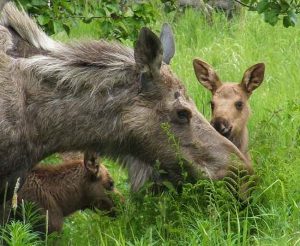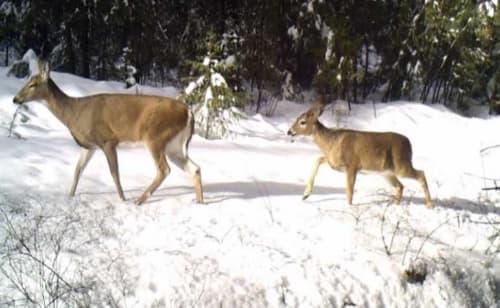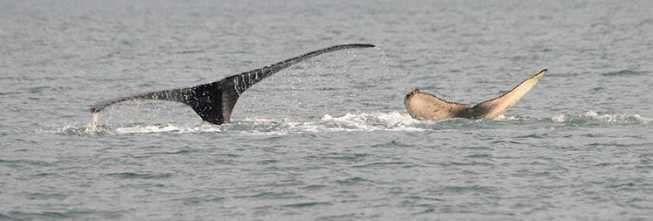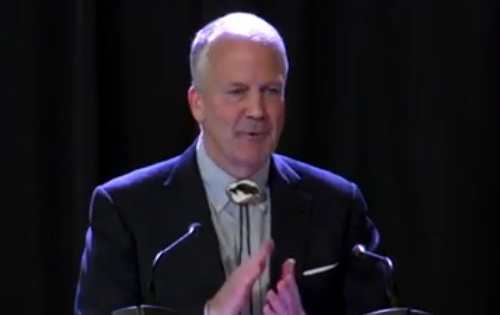
A newborn moose calf found alone in the woods – or even in your backyard – can appear helpless and abandoned. But don’t be fooled. Destitute as those big-eyed calves may seem, a protective mother is almost always nearby.
Newborn moose calves, deer fawns, and tiny bear cubs are already being seen in Alaska, the first of many calves, cubs, kits, and chicks Alaskans can expect to appear between mid-May and the end of June. Biologists are warning Alaskans who may encounter newborn wildlife to resist the urge to approach or “rescue” them.
Cow moose can be particularly dangerous during calving season, warns Anchorage Area Wildlife Biologist Dave Battle. Attacks on people and pets by cows aggressively defending calves are reported each spring.
“You’ll want to give moose calves plenty of space,” said Battle.
If a moose calf or bear cub is encountered without its mother immediately in view, be alert in case you’ve walked between them. The best course of action is usually to back away and leave from the direction you came. Also, do not assume young animals found alone are orphaned. Mother moose and bears frequently walk out of sight, cache their young, or become separated from them by fences or roads. Sow bears often send cubs up trees to wait before leaving to find food. In nearly all cases, the mothers return to their young.
Battle also advises Alaskans to take steps to avoid potentially dangerous encounters with wildlife mothers. “Try to avoid single tracks and narrow, brushy trails where limited visibility might lead to a run-in with a cow moose and calf.”
Bicyclists and runners should be especially alert as they can swiftly top hills or round corners and run into moose, bears and other wildlife. Making noise to alert wildlife to your presence is always a good precaution but may not be enough when speeding down a trail to avoid clashes with moose cows with calves.
[content id=”79272″]
“Newborn moose calves aren’t able to run from predators – or from pets or people on bicycles,” Battle said. “Mothers are likely to stand their ground, even when they hear you coming.”
Moose calves are not the only animal receiving unwanted attention. Paul Converse in Douglas said the Southeast office receives calls about birds, young porcupines, and especially black-tailed deer fawns.
“There have been instances where people have picked up and tried to care for a deer fawn,” he said. “A few years ago we learned a woman was taking care of an otter.”
He appreciates that people are well-intentioned but wishes they would not put themselves in these roles. “Please leave them alone and contact Fish and Game if you are concerned.”
Sitka Area Biologist Stephen Bethune said black-tailed deer mothers stay away from their newborn fawns to avoid drawing predators.
“Does will cache them for several hours while they go off and feed,” he said. “It’s a strategy. It’s safer for the fawn to not be with the doe while she’s feeding. It’s not orphaned, and people are actually kidnapping it.”
Tony Hollis in Fairbanks said the office there gets a few calls about moose calves each year, “but a majority of the issues are with the public bringing in young birds, hares, squirrels, and fox pups in a box and asking us what to do with them.”
“They might be abandoned, but probably not and they have a better chance out there,” he said.
Even when young animals truly are orphaned it’s best to leave them alone. Don’t attempt to feed or pick them up; this type of contact with animals is illegal and could result in a citation and fine. Lingering near or approaching a young animal for a photo may discourage the mother from returning.
If you observe a young animal that appears to have been left alone for more than 48 hours, contact the nearest Alaska Department of Fish and Game office during regular business hours, or use the department’s smartphone-friendly link to file a report online by visiting www.adfg.alaska.gov and clicking the “Report a Wildlife Encounter” button. If a situation involves an immediate public safety concern, call 9-1-1.
For more information, visit www.adfg.alaska.gov/index.cfm?adfg=distressedwildlife.mammals.
###







